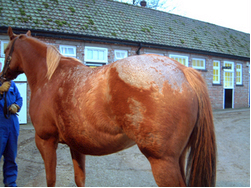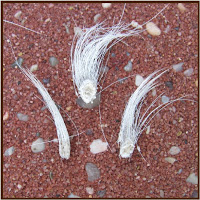 Rain scald, sometimes called rain rot, is a nasty and sometimes very frustrating skin condition caused by a bacteria but triggered by heavy, prolonged rain, fly bites or other skin damage – it requires someone who carries the bacteria nearby, plus moisture and skin trauma of some kind. It is contagious through sharing rugs, brushes and saddle pads etc.
Rain scald, sometimes called rain rot, is a nasty and sometimes very frustrating skin condition caused by a bacteria but triggered by heavy, prolonged rain, fly bites or other skin damage – it requires someone who carries the bacteria nearby, plus moisture and skin trauma of some kind. It is contagious through sharing rugs, brushes and saddle pads etc.
Veterinary treatment includes shampooing an infected horse with a medicinal shampoo every day for for 5 to 7 days, then twice weekly until all the lesions have healed – with bad cases having a course of antibiotics. You can read more about the veterinary information around rain scald at this link. But if you do, come back here for the easiest fix I’ve ever come across. 🙂

I went out to feed one morning recently after some heavy summer rain and was shocked to see/feel the little bumps that told me that I had 6 horses with it – all my chestnut colored horses and the only black. All the bay horses and greys were still glossy and shiny and in good health.
Pat Coleby (author of the book Natural Horse Care) says that rain scald and mud fever have lack of copper at the root of it and the fact that it was all the chestnut horses and the black too, who had the rain scald (those colors need more copper than the other colors) would suggest that she was right. Over the decades that I’ve known of her work in mineralising both the animals and the land, I’ve found that she normally is!
I already had copper pipe in my water, but gave the horses a SECOND source of water and boosted the copper in just ONE source of water so as to give the horses who DIDN’T need the extra copper, the opportunity to choose normal water. That should attend to the underlying mineral issue.
Now to the easy fix that I discovered.
Diatomaceous Earth (D.E.) is an anti-bacterial substance as well as a great natural wormer and killer of fleas on dogs and lice and mites on chickens. It’s also great for breaking the insect cycle by sprinkling into areas of infestations where the dogs lay and sleep and where chickens roost and the dust rolls where they fluff their feathers. It dries out the outer hard shell of the insect and kills them that way.
But back to the rain scald. It was a bit cold so I didn’t want to wash horses and hey washing seven horses every day for a week? (You can’t hear my voice rising at the thought of so much work!)
So I got the idea to try out the anti-bacterial properties of Diatomaceous Earth. I dipped a stiff brush into the D.E. and very gently rubbed all the affected areas in a circular motion, loosening off and removing the scabs and spreading D.E. everywhere that I worked. I don’t have the kind of brush that I needed for each of my 12 horses, so I kept the brush filled up with DE and gave it a good soak in vinegar after I had cleaned it and I won’t use this brush for any normal brushing again. It will be the one on the plastic bag labelled rain scald brush… 🙁
Important note: Work carefully and quietly, don’t have this stuff drifting through the air – you do not want to be breathing it.
I get my D.E. from here. Make sure that it is super fine food grade D.E. then you can use it for all the purposes, like non toxic worming as well and even for human consumption. I buy it 4.5 kilos at a time.
Three days later I noticed that most of the powder had gone and there was some small new areas of infection, so I scratched out the little scabs with the brush filled with D.E. again and then again a few days later. And two horses required a fourth application.
And that was it – the best and easiest fix for rain scald that I have ever come across and one that can be done in colder weather without having to risk wet horses getting a chill.
And remember, be careful to avoid future contamination through sharing of rugs and brushes and saddle pads etc and disinfect anything that has been in contact with a rain scalded horse.
The things that make ordinary horse people seriously good with horses are what I am really passionate about – mental, emotional and physically feeling good for both horses and people – that and doing things easily, without struggle. One of the reasons that I blog is to spread this information around. We have 9 free lessons that I think might just change you and your horse’s life. Get your free lessons the 9 Keys to Happiness with Your Horse here – they’ve had rave reviews from all over the world.
And don’t forget to sign up for my blog – a mixture of a gentle and very different approach to horse “training” and horse and human health. 🙂
I’m confused so you used the food D.E and rubbed it on the horse?
Great advice that I used on a chestnut mare that had rain rot! She lives with 2 other non-affected horses in a pasture that is currently being leveled with heavy machinery. There is noise and stress. Her rain rot symptoms began with the construction. I applied diatomaceous earth for 3 days. Then Shapely’s hair grower once. I added 12″ piece of copper tubing to the horse trough. Her hair has grown back within a week! Thank you so much!
Excellent Nina. I didn’t use the hair grower product and still got the same result. 🙂
We live in a “rainforest” . We are fortunate to have an open barn with lots of run-in area, the horses are never stalled nor blanketed,and we never have any problems. We did have problems years ago before adopting this system and yes, it was the chestnut horses that had issues. Interesting.
Thanks Jenny.
I would love an open run in barn too Anne-Marie. I’ll put it on my “I gotta have it” list!
Perfect timing as always Rhamie has rain scold so I will do this now
It’s a bad time for it – that hot and cold and wet then hot again. 🙁
Excellent jenny! I moved countries to escape non-stop, low level mud fever and no creams worked. I will try this if it ever comes back, thanks
Thanks Jenny, so far so good – but one never knows…will store that for future use if need be. Kathy